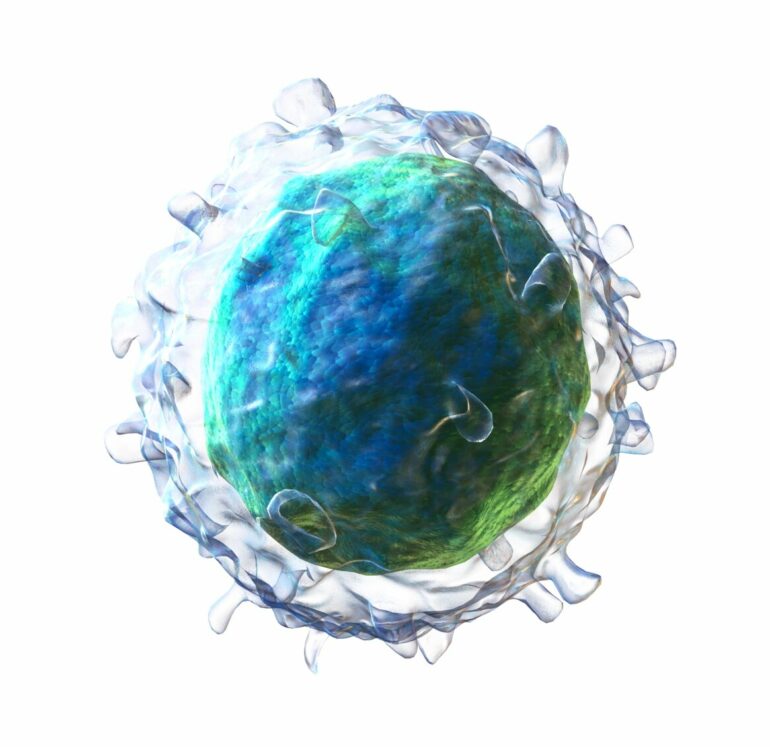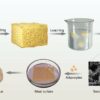Molecular biology’s central dogma posits a simple recipe for the construction of the human body: a DNA blueprint is transcribed into an RNA message, and the RNA message is translated into the proteins that make you. Translating the mRNA message is a bit like an assembly line.
The individual nucleotide “letters” in mRNA form three-letter sequences called codons. Another type of RNA molecule, the transfer RNA (tRNA), recognizes a specific codon on one of its ends and attaches to a specific amino acid on the other end. The amino acids comprise the final protein.
The magnitude of protein production varies wildly by the protein, the type of cell in which it is produced, and what that cell is doing at that moment in time. A type of protein notable for incredibly high production is the antibody family, which must be rapidly generated in high quantities to fight infection.
The work of protein production is stressful for cells, and the antibody-producing B cells are known to undergo metabolic shifts to support antibody secretion.
Sophie Giguere, an immunology student at Harvard Medical School who recently completed her Ph.D. in the Batista lab at the Ragon Institute, had another question: in simple organisms, and for certain proteins in more complex, multi-cellular organisms, high levels of production are associated with unusual patterns of codon use. How do antibodies compare?
Dr. Giguere’s interest in immunology, and in the antibody-producing B cells, was driven by her appreciation for the role vaccines play in public health. It was the intellectual ferment of Cambridge’s technology hub, however, that drove her interest in codon bias in immune cells. “My really good friend from undergrad was working on alternate genetic codes…. At the same time, I had just heard a lecture on T cell differentiation and started wondering if codon bias could vary across different cell states.”
Her bioinformatic dive revealed a peculiar quirk of antibody sequences: they frequently use codons without a “matching” tRNA in the genome.
The problem of codons with no apparent decoding mechanism was an early puzzle in genetics, and Francis Crick, one of the discoverers of the DNA helix, proposed quite early that this could be solved by tRNA “wobble”—a capacity to translate multiple codons that is now a well-known quirk of genetics.
Which codons tRNAs can translate are affected by chemical modifications to those tRNAs; Dr. Giguere found one particular modification known as a “super-wobbler,” inosine (I34), at higher rates in plasma cells—which produce high levels of antibodies.
There are 64 possible codon combinations and only 20 amino acids are used in human proteins. Since multiple codons can encode the same amino acid, Dr. Giguere genetically engineered cell lines to replace codons that require I34 with codons that do not, but encode the same amino acid—editing the instructions but making the same protein.
She found that antibody-producing cells were more efficient than non-antibody-producing cells when it came to translating I34-dependent codons. When she looked at mice with B cell receptors (essentially membrane-bound antibodies) that were identical as proteins but encoded differently, Dr. Giguere observed that B cells expressing more I34-dependant receptors seemed to be more likely to survive.
“It was surprising to me; the most common codons used in human antibody heavy chains, over and over, were ones with no corresponding tRNA gene in the genome,” says Prof. Facundo D. Batista, Ph.D., Associate and Scientific Director of the Ragon Institute and Dr. Giguere’s Ph.D. mentor. “I have worked on B cell receptors my entire career, and I had never considered this angle. Every immunologist I spoke to shared a similar reaction.”
The practical implications are immense: antibody production for laboratory and therapeutic use is an enormous industry, and antibodies are the key mediators of vaccine efficacy. Prof. Batista says, “I spend a lot of time working on which antibodies we want rationally designed vaccines to elicit: now, I will consider how those antibodies are encoded.”
The work is published in the journal Science.
More information:
Sophie Giguère et al, Antibody production relies on the tRNA inosine wobble modification to meet biased codon demand, Science (2024). DOI: 10.1126/science.adi1763
Provided by
Ragon Institute of MGH, MIT and Harvard
Citation:
Efficient antibody production ‘wobbles,’ new study finds (2024, January 12)



